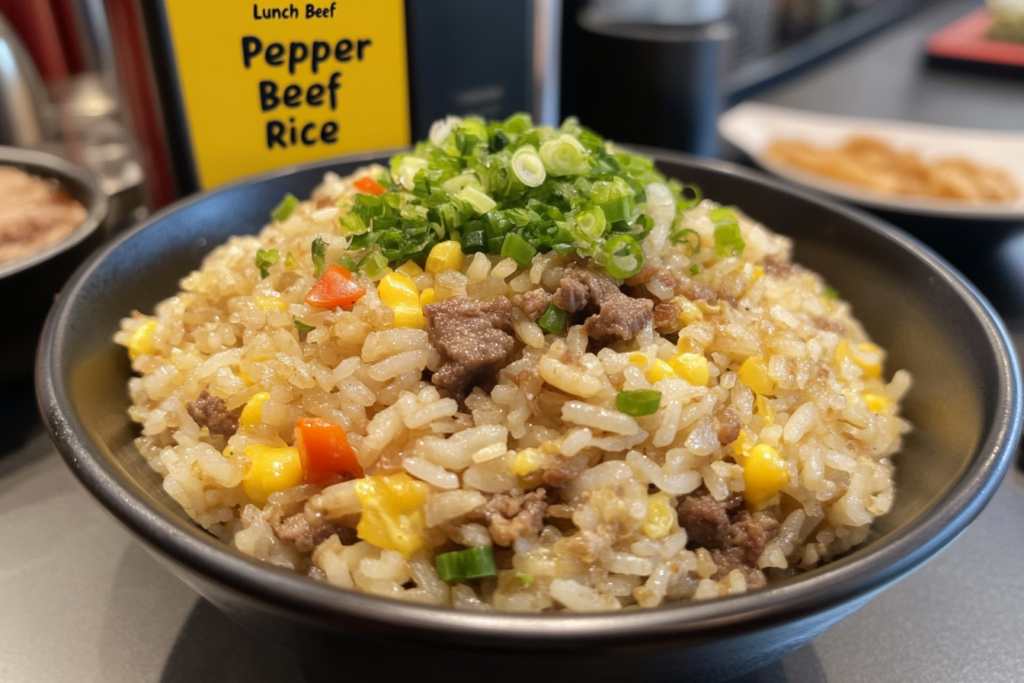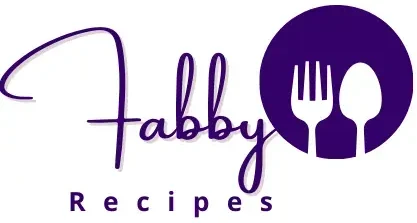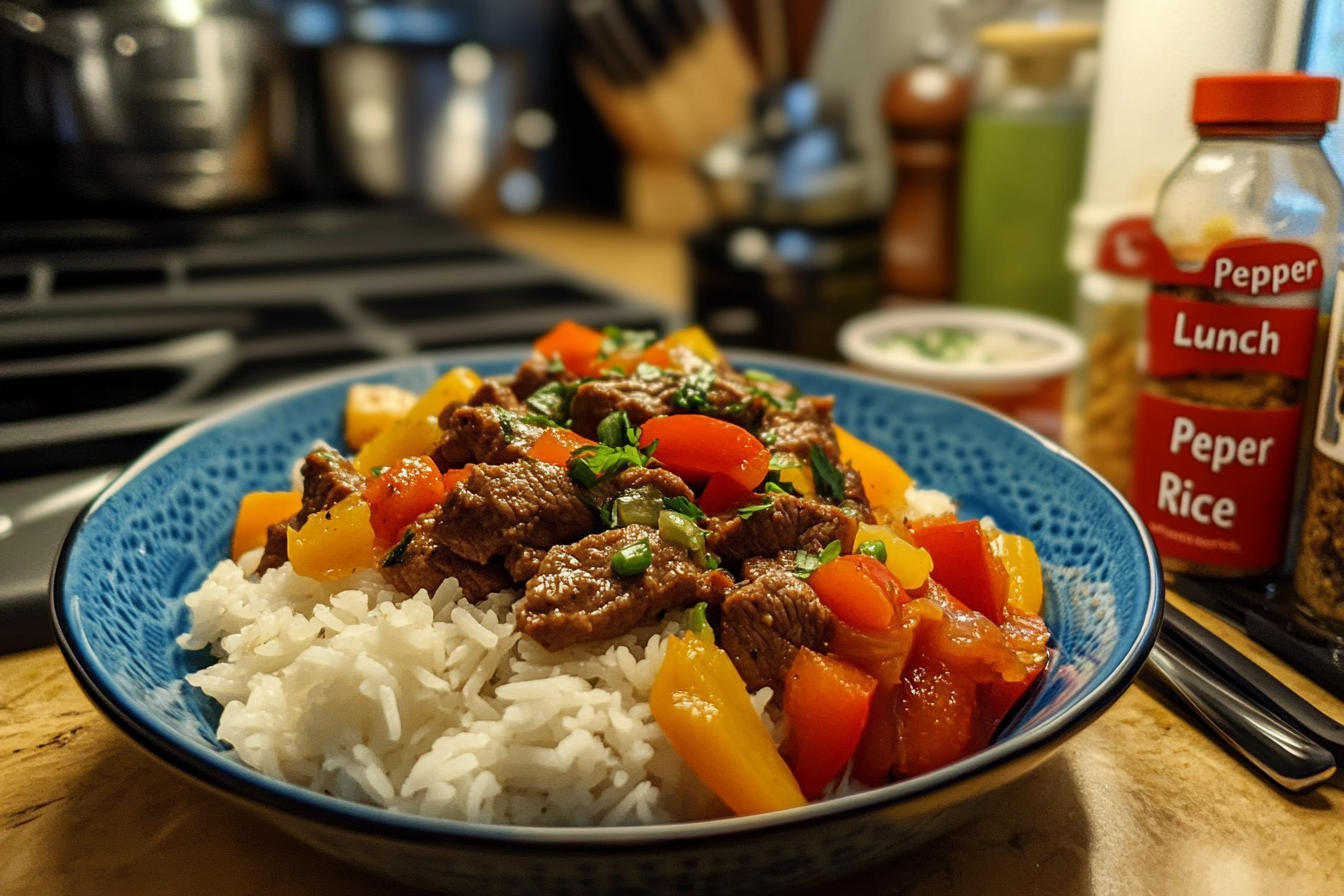Master the Art of Making Pepper Lunch Beef Pepper Rice at Home
Discover how to make Pepper Lunch Beef Pepper Rice at home with this authentic recipe, featuring sizzling flavors and easy-to-follow steps.
The sizzling aroma, the vibrant colors, the satisfying sound of a hot plate in action—Pepper Lunch Beef Pepper Rice embodies all of these sensory delights. This beloved Japanese dish has become a global favorite, thanks to its irresistible combination of tender beef, fluffy rice, butter, corn, and a generous dash of black pepper. But how did it rise to such fame? And what makes it so special? In this article, we’ll explore its origins, uncover its secrets, and guide you on how to recreate its magic in your own kitchen. Let’s dive into the tantalizing story of Pepper Lunch Beef Pepper Rice.
Discovering Pepper Lunch Beef Pepper Rice
Pepper Lunch is more than just a fast-food chain—it’s an experience. Founded in Japan, this unique restaurant concept revolves around the sizzling hot plate, which transforms every meal into a dynamic and interactive culinary event. Among its standout offerings is the Beef Pepper Rice, a dish that perfectly balances simplicity and sophistication.
This meal is served on a scorching iron plate, allowing customers to cook the components to their liking. As the butter melts and the beef sizzles, the rich flavors meld together in a way that’s utterly captivating. It’s no wonder Beef Pepper Rice has gained an international fan base, becoming a go-to comfort food for many.
The Origins of Pepper Lunch
The story of Pepper Lunch began in 1994 when Japanese chef Kunio Ichinose introduced an innovative fast-casual dining concept. The goal? To provide high-quality meals at an affordable price. By using heated iron plates, customers could enjoy freshly cooked food right at their tables—a novelty at the time.
The brand quickly grew, gaining a reputation for its distinct approach to fast food. Its signature dishes, especially Beef Pepper Rice, highlighted the essence of Japanese cuisine: fresh ingredients, balanced flavors, and visual appeal. As Pepper Lunch expanded across Asia and into other continents, it carried the sizzle of its signature iron plates far and wide.
Evolution of the Beef Pepper Rice Dish
Over the years, Beef Pepper Rice evolved into more than just a menu item—it became synonymous with the Pepper Lunch experience. Initially created to showcase the simplicity of high-quality ingredients, the dish resonated with customers who craved both taste and novelty.
Its popularity inspired creative twists, like adding cheese or eggs, and adapting it to local tastes in different countries. Beyond its flavor, the interactive cooking process—where diners mix and season the dish themselves—cemented its appeal. It’s not just about eating; it’s about engaging with your food.
Culturally, Beef Pepper Rice reflects Japan’s culinary philosophy of combining tradition with innovation. Whether you’re a first-time visitor to Pepper Lunch or a loyal fan, this dish invites you to be part of a sizzling culinary tradition that’s constantly evolving yet deeply rooted in its origins.
Ingredients and Preparation
Creating Pepper Lunch Beef Pepper Rice at home is all about combining simple yet flavorful ingredients with the right preparation techniques. Each component—whether it’s the tender beef, fluffy rice, or freshly ground black pepper—plays a crucial role in achieving that sizzling, mouthwatering experience. Below, we’ll explore the essential ingredients, share expert tips on selection, and guide you step-by-step to recreate this beloved dish.
Essential Ingredients for Beef Pepper Rice
At its heart, Beef Pepper Rice celebrates the harmony of fresh, high-quality ingredients:
- Thinly sliced beef: The star of the dish, offering a juicy, melt-in-your-mouth texture.
- Rice: White, short-grain rice works best for its stickiness and flavor.
- Butter: Adds richness and a smooth, creamy texture.
- Corn kernels: Contribute a touch of sweetness that balances the savory notes.
- Soy sauce: Enhances umami and depth of flavor.
- Freshly ground black pepper: Provides the iconic spice and aroma that defines the dish.
Selecting the Right Cut of Beef
To ensure tenderness and flavor, choose cuts like sirloin, ribeye, or tenderloin. These cuts cook quickly and remain juicy even on high heat.
For optimal results, use a sharp knife to slice the beef thinly against the grain. This technique ensures the fibers are shorter, making the meat tender and easier to chew. To achieve the best thinness, partially freeze the beef for 20 minutes before slicing. It’s a small trick that yields big rewards in the pan.
Importance of Freshly Ground Black Pepper
The pepper in Beef Pepper Rice isn’t just a seasoning—it’s a statement. Using freshly ground black pepper amplifies the dish’s flavor profile, offering a spicy kick and a floral aroma.
Pre-ground pepper loses its potency over time, so grinding it fresh ensures maximum flavor and aroma. If possible, opt for high-quality peppercorns like Tellicherry for a more robust and complex taste. This seemingly small detail can elevate your homemade Pepper Lunch Beef Pepper Rice to restaurant-quality levels.
Role of Butter and Corn in the Recipe
Butter is the unsung hero of this dish. Its rich, creamy texture coats the rice and beef, tying all the flavors together beautifully. Meanwhile, corn kernels offer a delightful contrast with their natural sweetness, balancing the dish’s savory and spicy elements.
For an authentic touch, use unsalted butter to control the dish’s sodium levels. As for the corn, fresh is ideal, but frozen or canned varieties work well too—just make sure to drain and pat them dry before adding them to the dish.
Step-by-Step Preparation Guide
Recreating the sizzling magic of Beef Pepper Rice requires careful attention to detail. Here’s a breakdown of the process:
Preparing the Beef Slices
Marinating the beef enhances its flavor and tenderness. A simple marinade of soy sauce, a dash of sesame oil, and a sprinkle of sugar complements the beef beautifully. Allow the slices to marinate for at least 15 minutes while you prepare the other components.
If you want to mimic the signature Pepper Lunch experience, don’t over-marinate the beef—it’s meant to cook and season directly on the hot plate, preserving its freshness.
Cooking the Rice to Perfection
Fluffy rice is the backbone of this dish. Rinse the grains thoroughly to remove excess starch, which can make the rice sticky. Cook it using a rice cooker or stovetop method, ensuring the water-to-rice ratio is accurate (1:1.25 for short-grain rice).
Once cooked, let the rice sit for 5-10 minutes to release steam and become firm yet soft. Avoid stirring the rice too soon, as this can break the grains and affect texture.
Assembling the Dish on a Sizzling Plate
The final assembly is where the magic happens. Heat a cast iron skillet or any thick-bottomed pan until it’s smoking hot. Arrange the cooked rice in the center, then top it with marinated beef slices, butter, corn, and freshly ground black pepper.
Allow the beef to sear on the plate, flipping it gently to cook evenly. Mix everything together right before serving to distribute the butter and pepper, creating that signature sizzling aroma.
Variations and Accompaniments
One of the joys of Pepper Lunch Beef Pepper Rice is its adaptability. While the classic version is beloved for its simplicity, creative twists and thoughtful pairings can elevate the dish into something uniquely your own. Whether it’s adding bold ingredients or pairing it with complementary sides, there’s no shortage of ways to customize and enhance this sizzling sensation.
Popular Variations of Beef Pepper Rice
The beauty of this dish lies in its versatility. Many variations have emerged, each adding a personal touch while retaining the essence of Beef Pepper Rice:
- Cheese Lover’s Delight: Adding grated cheddar or mozzarella cheese creates a gooey, indulgent twist.
- Egg-topped Sizzle: Crack a fresh egg onto the hot plate for an added layer of richness. The egg cooks as you mix it in, creating a silky texture.
- Regional Flavors: Some variations incorporate local spices, sauces, or meats, such as teriyaki sauce for a sweeter note or spicy gochujang for a Korean-inspired kick.
These adaptations showcase the dish’s global appeal while honoring its Japanese roots. Experimenting with these variations can make each preparation an exciting new adventure.
Incorporating Vegetables for Added Flavor
Vegetables aren’t just nutritious—they can also add vibrant colors and layers of flavor to your Pepper Lunch Beef Pepper Rice. Consider these additions:
- Bell peppers: Their natural sweetness and slight crunch complement the dish beautifully.
- Mushrooms: Shiitake or button mushrooms add a meaty, earthy flavor that pairs well with beef.
- Broccoli: Steamed broccoli adds a fresh, crisp contrast to the buttery, savory components.
When adding vegetables, chop them into bite-sized pieces and sauté them briefly before mixing into the dish. This ensures they maintain their texture and don’t overpower the other ingredients.
Using Different Types of Rice
Rice is the foundation of Beef Pepper Rice, but you can experiment with alternatives to suit your preferences or dietary needs:
- Jasmine rice: Its floral aroma brings a fragrant twist to the dish.
- Brown rice: A healthier option that offers more fiber and a slightly nutty flavor.
- Cauliflower rice: Ideal for those looking to reduce carbs, this low-calorie alternative absorbs the flavors of the dish surprisingly well.
Each type of rice brings a unique texture and taste, proving that there’s no one “right” way to enjoy this meal.
Ideal Side Dishes to Complement the Meal
Pairing Beef Pepper Rice with the right accompaniments can turn it into a complete and satisfying feast. Here are some recommendations:
- Miso soup: This traditional Japanese soup adds warmth and umami, balancing the richness of the dish.
- Pickled vegetables: Items like pickled radish or cucumber bring a tangy, refreshing contrast.
- Fresh salad: A light salad with a sesame or ginger dressing cuts through the richness and adds a refreshing element.
These sides enhance the overall dining experience, offering a mix of textures and flavors that complement the sizzling main dish perfectly.
Nutritional Information and Health Considerations
Pepper Lunch Beef Pepper Rice isn’t just a feast for the senses; it also packs a nutritional punch. Whether you’re counting calories or exploring the health benefits of its ingredients, understanding the dish’s nutritional profile can help you make informed choices. Below, we’ll analyze its caloric content, macronutrients, and the inherent benefits of its components. For those seeking a healthier twist, practical tips are just ahead!

Nutritional Breakdown of Beef Pepper Rice
Caloric Content and Macronutrient Distribution
A standard serving of Beef Pepper Rice offers a balanced combination of macronutrients:
- Calories: Approximately 600-700, depending on portion size and added ingredients.
- Protein: With thinly sliced beef as its star, the dish provides 30-40 grams of high-quality protein—ideal for muscle repair and growth.
- Carbohydrates: The rice delivers about 70-80 grams of carbs, providing energy and aiding digestion.
- Fats: Butter and beef contribute 20-25 grams of fats, offering flavor and satiety, though moderation is key.
These figures make Beef Pepper Rice a filling meal that satisfies without overindulgence, provided you enjoy it in moderation.
Health Benefits of Key Ingredients
- Beef: A rich source of iron, zinc, and B vitamins, beef promotes energy and immune health.
- Black pepper: Known as the “king of spices,” black pepper contains piperine, which may aid digestion and enhance nutrient absorption.
- Butter: While often debated, butter in small quantities provides vitamin A and healthy fats that support brain function.
These ingredients not only contribute flavor but also offer essential nutrients that benefit overall well-being.
Tips for a Healthier Version
Reducing Sodium and Fat Content
To make Beef Pepper Rice a healthier option:
- Low-sodium soy sauce: Swap regular soy sauce for its low-sodium counterpart to significantly cut down on salt.
- Healthier fats: Replace butter with olive oil or avocado oil for a dose of heart-healthy monounsaturated fats.
Small adjustments like these can help you enjoy the dish without compromising on flavor or health.
Incorporating Whole Grains and Vegetables
Boost the fiber and nutrient content by opting for:
- Whole grains: Substitute white rice with brown rice, quinoa, or bulgur for added fiber and a nuttier taste.
- Vegetables: Add generous portions of spinach, carrots, or zucchini to increase vitamins and minerals while reducing the calorie density of the dish.
These additions not only enhance the dish’s nutritional profile but also introduce a variety of textures and flavors, making it even more satisfying.
FAQs about Pepper Lunch Beef Pepper Rice
Curious about the sizzling magic of Pepper Lunch Beef Pepper Rice? You’re not alone! Below, we answer some of the most common questions about this beloved dish, from its fascinating origins to tips for recreating its iconic sizzle at home.
What is the origin of Pepper Lunch Beef Pepper Rice?
Pepper Lunch Beef Pepper Rice has its roots in Japan, created by Kunio Ichinose, the founder of the Pepper Lunch fast-food chain. Introduced in 1994, this dish became a standout for its interactive dining experience, where customers could mix and cook their meal on a sizzling hot plate.
The concept quickly gained popularity, blending Japan’s culinary traditions with modern, casual dining. As the brand expanded globally, Beef Pepper Rice emerged as an international favorite, celebrated for its bold flavors and simplicity. Its sizzling presentation remains a hallmark, captivating diners worldwide.
Can I use other types of meat for this dish?
Absolutely! While thinly sliced beef is the classic choice, this versatile dish can easily adapt to other proteins:
- Chicken: Use boneless, skinless chicken breast or thigh, sliced thinly for quick cooking.
- Seafood: Shrimp, scallops, or even salmon bring a fresh twist to the dish.
The key is to ensure the meat is thinly sliced for even cooking on the hot plate. Pair the alternative meat with complementary seasonings, and you’ll have a delicious variation of the original recipe.
How do I achieve the sizzling effect at home?
Recreating the sizzling presentation is easier than you think! Here’s how:
- Use a cast iron skillet or any heavy-bottomed pan that retains heat well. Preheat the skillet on high until it’s smoking hot.
- Assemble the dish by placing cooked rice in the center and surrounding it with thinly sliced, marinated beef, butter, and corn.
- Serve immediately and allow the hot skillet to cook the beef and meld the flavors together.
This technique ensures a dramatic, restaurant-quality sizzle right at your dining table!

